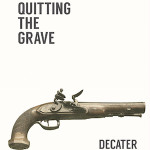The Seven Phases Of A Successful Kickstarter Campaign, Part One

Let me start off by making something very clear. There are NO magical formulas that will ensure a successful crowdfunding campaign. Reaching your goal depends entirely on your effort. All those blog posts that make it sound easy, they are just link bait.
I’ve run two successful campaigns on Kickstarter. The first, for my ebook release of Picasso Painted Dinosaurs, was a test. It was for a small amount that I could have easily paid myself. But I was curious how many strangers I could get to donate. The answer was not very many (Though the fact that I did have a couple strangers contribute did feel good).
I learned a lot from that first one, including that it was going to take more than just posting my project and hoping for the best. With my second campaign, for Quitting the Grave, I was asking for $8,000. I spent two months preparing, and it occupied the majority of my free time for an entire month, but in the end I made it.
Neither campaign was perfect. I definitely would do a number of things differently if I ever run another one. But they did succeed and I’d like to share what I learned with all of you, in the hopes that it will be of some help.
Step One: Come up with an idea and pick your platform.
Not every fund raising scheme is suitable for Kickstarter. The first thing you need to realize is that KS is only for tangible products: An item of clothing, a smart watch, a film, a memoir. Something that you’ll be able to sell.
You can’t raise money for the restaurant you want to open or fund your new consulting business. You can’t use KS to solicit donations for a charity, or to pay off a hospital bill. You need a finished product(s) that people will be able to buy.
Indiegogo offers more flexibility. You’re able to ask for money for pretty much anything you want. Hey, give me five million dollars so I can quit my job and live on the beach. I’m not sure why anyone would contribute to that, but you can give it a try on Indiegogo.
So why use Kickstarter at all? For one, their platform is a lot bigger. As of 2013, KS campaigns had successfully raised six times as much money, with a significantly higher success rate and more than double the number of campaigns. Indiegogo is closing the gap in terms of name recognition, but the KS platform is still well in the lead (Learn More Here).
Maybe even more importantly, research has shown the all-or-nothing paradigm helps engender success. For whatever reason, the knowledge that a failure to reach your goal means you end up with nothing seems to encourage people to donate.
My advice, which will continue over the next week, applies directly to KS, because that’s the platform I’m most familiar with, and the one I recommend. However, although not everything I suggest will translate to Indiegogo or another platform, much of it will.
 Check out Decater's new novel, available now at Amazon. Plus, don't forget his earlier books: Ahab's Adventures in Wonderland and Picasso Painted Dinosaurs.
Check out Decater's new novel, available now at Amazon. Plus, don't forget his earlier books: Ahab's Adventures in Wonderland and Picasso Painted Dinosaurs.


